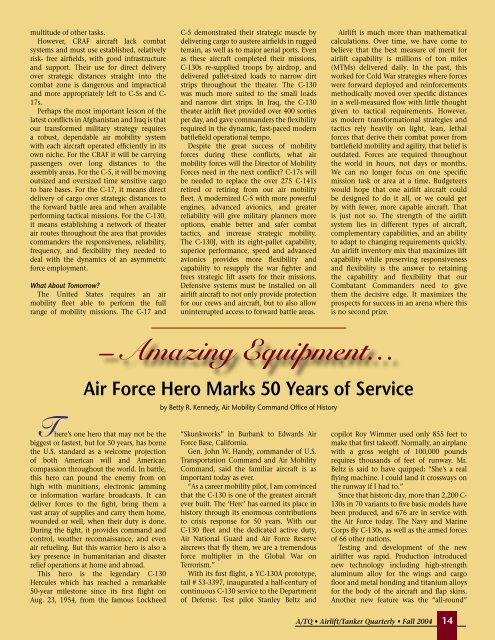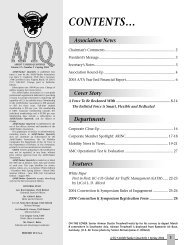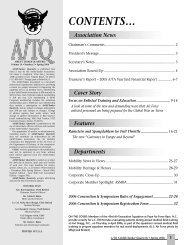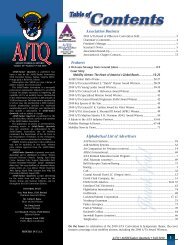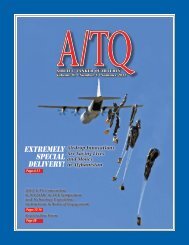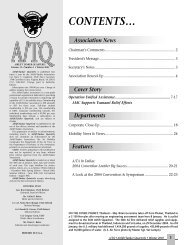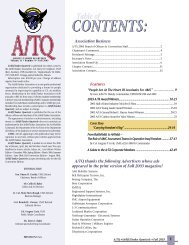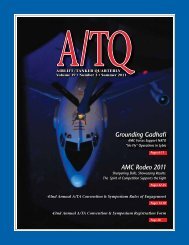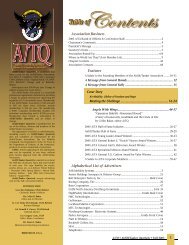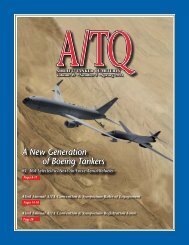ATQ Fall 2004 (pages) for pdf - Airlift/Tanker Association
ATQ Fall 2004 (pages) for pdf - Airlift/Tanker Association
ATQ Fall 2004 (pages) for pdf - Airlift/Tanker Association
You also want an ePaper? Increase the reach of your titles
YUMPU automatically turns print PDFs into web optimized ePapers that Google loves.
multitude of other tasks.<br />
However, CRAF aircraft lack combat<br />
systems and must use established, relatively<br />
risk- free airfields, with good infrastructure<br />
and support. Their use <strong>for</strong> direct delivery<br />
over strategic distances straight into the<br />
combat zone is dangerous and impractical<br />
and more appropriately left to C-5s and C-<br />
17s.<br />
Perhaps the most important lesson of the<br />
latest conflicts in Afghanistan and Iraq is that<br />
our trans<strong>for</strong>med military strategy requires<br />
a robust, dependable air mobility system<br />
with each aircraft operated efficiently in its<br />
own niche. For the CRAF it will be carrying<br />
passengers over long distances to the<br />
assembly areas. For the C-5, it will be moving<br />
outsized and oversized time sensitive cargo<br />
to bare bases. For the C-17, it means direct<br />
delivery of cargo over strategic distances to<br />
the <strong>for</strong>ward battle area and when available<br />
per<strong>for</strong>ming tactical missions. For the C-130,<br />
it means establishing a network of theater<br />
air routes throughout the area that provides<br />
commanders the responsiveness, reliability,<br />
frequency, and flexibility they needed to<br />
deal with the dynamics of an asymmetric<br />
<strong>for</strong>ce employment.<br />
What About Tomorrow?<br />
The United States requires an air<br />
mobility fleet able to per<strong>for</strong>m the full<br />
range of mobility missions. The C-17 and<br />
C-5 demonstrated their strategic muscle by<br />
delivering cargo to austere airfields in rugged<br />
terrain, as well as to major aerial ports. Even<br />
as these aircraft completed their missions,<br />
C-130s re-supplied troops by airdrop, and<br />
delivered pallet-sized loads to narrow dirt<br />
strips throughout the theater. The C-130<br />
was much more suited to the small loads<br />
and narrow dirt strips. In Iraq, the C-130<br />
theater airlift fleet provided over 400 sorties<br />
per day, and gave commanders the flexibility<br />
required in the dynamic, fast-paced modern<br />
battlefield operational tempo.<br />
Despite the great success of mobility<br />
<strong>for</strong>ces during these conflicts, what air<br />
mobility <strong>for</strong>ces will the Director of Mobility<br />
Forces need in the next conflict? C-17s will<br />
be needed to replace the over 275 C-141s<br />
retired or retiring from our air mobility<br />
fleet. A modernized C-5 with more powerful<br />
engines, advanced avionics, and greater<br />
reliability will give military planners more<br />
options, enable better and safer combat<br />
tactics, and increase strategic mobility.<br />
The C-130J, with its eight-pallet capability,<br />
superior per<strong>for</strong>mance, speed and advanced<br />
avionics provides more flexibility and<br />
capability to resupply the war fighter and<br />
frees strategic lift assets <strong>for</strong> their missions.<br />
Defensive systems must be installed on all<br />
airlift aircraft to not only provide protection<br />
<strong>for</strong> our crews and aircraft, but to also allow<br />
uninterrupted access to <strong>for</strong>ward battle areas.<br />
<strong>Airlift</strong> is much more than mathematical<br />
calculations. Over time, we have come to<br />
believe that the best measure of merit <strong>for</strong><br />
airlift capability is millions of ton miles<br />
(MTMs) delivered daily. In the past, this<br />
worked <strong>for</strong> Cold War strategies where <strong>for</strong>ces<br />
were <strong>for</strong>ward deployed and rein<strong>for</strong>cements<br />
methodically moved over specific distances<br />
in a well-measured flow with little thought<br />
given to tactical requirements. However,<br />
as modern trans<strong>for</strong>mational strategies and<br />
tactics rely heavily on light, lean, lethal<br />
<strong>for</strong>ces that derive their combat power from<br />
battlefield mobility and agility, that belief is<br />
outdated. Forces are required throughout<br />
the world in hours, not days or months.<br />
We can no longer focus on one specific<br />
mission task or area at a time. Budgeteers<br />
would hope that one airlift aircraft could<br />
be designed to do it all, or we could get<br />
by with fewer, more capable aircraft. That<br />
is just not so. The strength of the airlift<br />
system lies in different types of aircraft,<br />
complementary capabilities, and an ability<br />
to adapt to changing requirements quickly.<br />
An airlift inventory mix that maximizes lift<br />
capability while preserving responsiveness<br />
and flexibility is the answer to retaining<br />
the capability and flexibility that our<br />
Combatant Commanders need to give<br />
them the decisive edge. It maximizes the<br />
prospects <strong>for</strong> success in an arena where this<br />
is no second prize.<br />
– Amazing Equipment…<br />
Air Force Hero Marks 50 Years of Service<br />
by Betty R. Kennedy, Air Mobility Command Office of History<br />
There’s one hero that may not be the<br />
biggest or fastest, but <strong>for</strong> 50 years, has borne<br />
the U.S. standard as a welcome projection<br />
of both American will and American<br />
compassion throughout the world. In battle,<br />
this hero can pound the enemy from on<br />
high with munitions, electronic jamming<br />
or in<strong>for</strong>mation warfare broadcasts. It can<br />
deliver <strong>for</strong>ces to the fight, bring them a<br />
vast array of supplies and carry them home,<br />
wounded or well, when their duty is done.<br />
During the fight, it provides command and<br />
control, weather reconnaissance, and even<br />
air refueling. But this warrior hero is also a<br />
key presence in humanitarian and disaster<br />
relief operations at home and abroad.<br />
This hero is the legendary C-130<br />
Hercules which has reached a remarkable<br />
50-year milestone since its first flight on<br />
Aug. 23, 1954, from the famous Lockheed<br />
“Skunkworks” in Burbank to Edwards Air<br />
Force Base, Cali<strong>for</strong>nia.<br />
Gen. John W. Handy, commander of U.S.<br />
Transportation Command and Air Mobility<br />
Command, said the familiar aircraft is as<br />
important today as ever.<br />
“As a career mobility pilot, I am convinced<br />
that the C-130 is one of the greatest aircraft<br />
ever built. The ‘Herc’ has earned its place in<br />
history through its enormous contributions<br />
to crisis response <strong>for</strong> 50 years. With our<br />
C-130 fleet and the dedicated active duty,<br />
Air National Guard and Air Force Reserve<br />
aircrews that fly them, we are a tremendous<br />
<strong>for</strong>ce multiplier in the Global War on<br />
Terrorism.”<br />
With its first flight, a YC-130A prototype,<br />
tail # 53-3397, inaugurated a half-century of<br />
continuous C-130 service to the Department<br />
of Defense. Test pilot Stanley Beltz and<br />
copilot Roy Wimmer used only 855 feet to<br />
make that first takeoff. Normally, an airplane<br />
with a gross weight of 100,000 pounds<br />
requires thousands of feet of runway. Mr.<br />
Beltz is said to have quipped: “She’s a real<br />
flying machine. I could land it crossways on<br />
the runway if I had to.”<br />
Since that historic day, more than 2,200 C-<br />
130s in 70 variants to five basic models have<br />
been produced, and 676 are in service with<br />
the Air Force today. The Navy and Marine<br />
Corps fly C-130s, as well as the armed <strong>for</strong>ces<br />
of 66 other nations.<br />
Testing and development of the new<br />
airlifter was rapid. Production introduced<br />
new technology including high-strength<br />
aluminum alloy <strong>for</strong> the wings and cargo<br />
floor and metal bonding and titanium alloys<br />
<strong>for</strong> the body of the aircraft and flap skins.<br />
Another new feature was the “all-round”<br />
14 A/TQ • <strong>Airlift</strong>/<strong>Tanker</strong> Quarterly • <strong>Fall</strong> <strong>2004</strong><br />
A/TQ • <strong>Airlift</strong>/<strong>Tanker</strong> Quarterly • <strong>Fall</strong> <strong>2004</strong><br />
14


